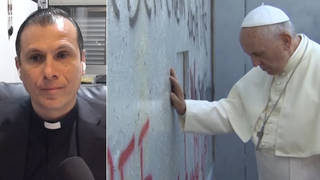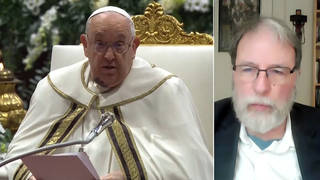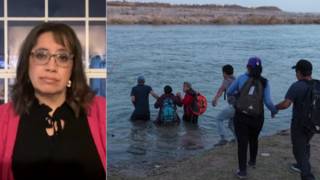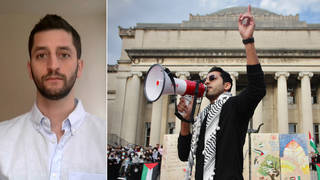
Guests
- Valerie Gonzalezinvestigative reporter who covers the Rio Grande Valley.
- Disonasylum seeker from Honduras and a member of the board at Solidarity Engineering. (His full name is being withheld for safety.)
- Chloe Rastatterfield engineer for Solidarity Engineering in Matamoros, Mexico.
One of the most controversial Trump-era immigration policies — the so-called Remain in Mexico program, officially called the Migrant Protection Protocols — left about 25,000 asylum seekers stranded on the other side of the border while their cases progressed through U.S. courts. President Joe Biden has suspended that program, but immigrant advocates say his administration needs to move more quickly to undo the damage. Although dozens of asylum seekers have been allowed to trickle in, many thousands are still waiting in dangerous conditions for their chance to cross the border, including in the Matamoros refugee camp across the border from Brownsville, Texas. It is the largest camp of its kind and holds hundreds of men, women and children seeking asylum, most of them fleeing extreme violence and poverty in Guatemala, El Salvador and Honduras. “We’ve gotten very little government support on the ground with this transition,” says Chloe Rastatter, a field engineer for Solidarity Engineering, a humanitarian organization that provides support in the Matamoros camp. “They say MPP is over, but there’s a camp of 1,000 people still here.” We also speak with Dison, an asylum seeker from Honduras who works with Solidarity Engineering, and investigative reporter Valerie Gonzalez, who covers the Rio Grande Valley.
Transcript
AMY GOODMAN: This is Democracy Now! The Quarantine Report. I’m Amy Goodman, with Juan González, as we look now at how the Biden administration has suspended one of the most controversial Trump policies, the so-called Remain in Mexico program, officially called the Migrant Protection Protocols, or MPP. Starting in January of 2019, the policy forced tens of thousands of asylum seekers who sought refuge in the United States to wait in dangerous conditions in crowded and squalid refugee camps along the border in Mexico while their cases made their way through U.S. courts — and often didn’t. Biden has put a hold on adding any new asylum seekers to the program and says about 25,000 of the people who are currently enrolled in the program will be allowed into the United states while their cases are processed, if they meet certain criteria.
This is asylum seeker Marlen, speaking to the advocacy group People Without Borders, Pueblo Sin Fronteras, about facing homelessness in Mexico with her family after they asked the U.S. for protection.
MARLEN: [translated] We vividly remember when we arrived to the immigration office in Mexico. They didn’t give us a place to sleep or anything to eat. Our children slept on the floor that night.
AMY GOODMAN: Well, on Friday, the first 25 asylum seekers in the MPP program crossed from Tijuana, Mexico, into San Diego, California. Homeland Security Secretary Alejandro Mayorkas says about 300 asylum seekers per day could soon be processed. But problems have been reported with the government’s new online portal, and the rollback of MPP has yet to start at another major border crossing, in Brownsville, Texas.
The Matamoros refugee camp on the other side of the border there is the largest one of its kind. It holds hundreds of men, women and children seeking asylum, most of them fleeing extreme violence and poverty in Guatemala, El Salvador and Honduras. Some have been waiting since July 2019, when MPP was expanded to the Texas border. Now they’ve endured freezing temperatures during the winter storm last week.
To learn more about the conditions in the camp and when people will allowed into the United States, we’re joined by three guests, on both sides of the border. In Edinburg, Texas, Valerie Gonzalez is with us, an investigative reporter covering the Rio Grande Valley for The Monitor, Valley Morning Star and The Brownsville Herald. And joining us from the Matamoros refugee camp in Mexico, Dison is with us, an asylum seeker from Honduras who fled his country in March 2019 and arrived at Matamoros refugee camp last February. He’s using his first name only in order to protect his safety and is a member of the board at Solidarity Engineering, which is working to improve conditions at the camp. Alongside Dison is Chloe Rastatter, a field engineer for Solidarity Engineering.
We welcome you all to Democracy Now! Valerie, we were going to speak to you Monday, but you were in the camp. We couldn’t reach you. So, you go back and forth between Matamoros and Texas. Talk about the conditions on the ground and what’s happening with MPP. Are asylum seekers going to be allowed through? Valerie, were you able to hear?
VALERIE GONZALEZ: I didn’t hear the question.
AMY GOODMAN: My question to you was: Talk about the conditions on the ground in Matamoros in these refugee camps and how the MPP program is now moving forward, with Biden reversing Trump’s policy.
VALERIE GONZALEZ: Sure, I can talk about the conditions. I apologize for problems hearing the question. So, the conditions have shifted over the time. As MPP started, it started with people just sleeping close to the bridge at the immigration office or outside of it. In the beginning, there was a couple of women who were pregnant, and they were sleeping under a desk that was outside. Then they were sleeping under a roof that was kind of open, and you could see it as you were going through the bridge. And then that shifted over into the plaza. Right before you cross the border, there is a plaza. And people were just kind of sleeping outdoors in tents, and it was pretty disorganized. Then it became a little bit more formal when people started just bringing more tents, and there was a lot of nonprofits and organizations who would help on the U.S. side and also on the Mexico side. And that slowly became a larger camp. And right by the plaza on another side of the fence — there is a fence that divides the plaza from a lateral park — they started pushing them that way, so the public could use the plaza again. And so, that area is where they’ve been living at, those who have remained by the plaza. And there’s been many who have left. At some point, the camp was in the thousands, about 2,000, I believe. And now as of the census that was taken about a week ago, there are 350 families, about 750 people.
And they were living in, and they are living in, tents. And you could just see different kinds of materials that are strung together to try and protect them from the weather. It was particularly difficult last week when we had frigid temperatures. I was out there with them overnight for one night, and it was challenging to see how they kept warm and how they kind of got going again in the morning. The water was hard to use. If you washed your hands, it would feel like it was burning your hands, because it was just so cold. But people are very resilient there. They have been adapting to all the different kinds of challenges that they face.
And aside from the weather, one of the most difficult challenges has been safety. There’s women living alone. Sometimes they have children, sometimes on their own. And that’s presented a lot of challenges to try and keep themselves safe. At night, some of the women will try and find someone else to go with, because it’s unsafe. There have been incidents that they were telling me about where men will enter their tents and harm them or just — you know, I think they fear what might happen to their personal safety. Thankfully, the woman that I spoke to had not been assaulted in any way, but she had — there had been an attempt, a man who tried to enter her tent. And she made a lot of noise. She called a neighbor. And she was able to find safety. But that is something that is a daily challenge.
JUAN GONZÁLEZ: I’d like to bring in Dison, if you could, to talk to us. You’re an asylum seeker from Honduras. Could you talk about how the Mexican government and the government officials have been dealing with the asylum seekers as they wait in the camps?
DISON: Well, good morning. This has been very challenging for the issue, Juan, because the government over here really not have been very much help to us. Most of the time, we have been approached for having — using really a strong way to direct ourselves. Our life was really feeling that when we was doing — getting the help we were needed for, and sometime we was looking for the help for.
CHLOE RASTATTER: Yeah, to kind of echo what Dison says, we’ve got, on the ground —
AMY GOODMAN: I also just want to say that our guests in Matamoros, in the camp, are wearing masks, so everyone should listen carefully. And, Chloe and Dison, when each of you speak, if you could move toward more the middle of the screen, I think it will be easier to hear you as you sit side by side.
CHLOE RASTATTER: Yeah. So, as Dison was saying, we’ve gotten very little government support on the ground with this transition. There was extreme cold in the camp this past week. The power outage has highly affected both the implementing of the website and the communication between the organizations and asylum seekers. So, there’s been a lot of questions. People were supposed to start crossing on Monday from the camp. That hasn’t happened. We’re not sure when it’s going to happen. The lawyers don’t know when it’s going to happen. They say MPP is over, but there’s a camp of a thousand people still here, and there’s 65,000 people who have been affected by this inhumane policy.
JUAN GONZÁLEZ: And in terms of the many people who are no longer in the camps, who originally applied for asylum but perhaps are no longer waiting in the camps, is there any — are there going to be any attempt to try to relocate them, either by groups, by civil society groups, or by the government itself, as far as you can tell?
CHLOE RASTATTER: Yeah. So, there are efforts. It’s quite complicated. Because people have been living in these conditions for two years, a lot of people have opted out to go home. A lot of people have crossed into the U.S. A lot of people have disappeared, and nobody knows where they’re going.
On top of that, although MPP is over, Title 42 is still being enacted. So we’re seeing effects of large migrations specifically in the Haitian population, but also with people from Central America, as well. They’re coming to our border. They’re getting stuck at the border in really dangerous conditions. It’s essentially stopping migration right at our border, causing a humanitarian crisis that can’t be addressed by who we have on the ground, because we have organizations who have been working with the people under MPP for two years. People have been living in absolutely terrible conditions, in extremely dangerous locations that are hard to reach for aid organizations. And then you have a huge influx of deportees coming in, and you have a huge influx of new migrants who are trying to come and cross but are being denied because of Title 42.
AMY GOODMAN: Chloe, just to understand, you said a huge number of deportees coming in. You mean people being deported from the United States, although —
CHLOE RASTATTER: Yeah.
AMY GOODMAN: — the Biden administration says they’re longer doing that.
CHLOE RASTATTER: Yes, exactly. We’re seeing deportees. And actually, the deportations that we’re seeing right now, at least at the Mexico border, is just creating a — it’s perpetuating the cycle of violence at the border, because a lot of the deportees are actually people who came to seek asylum and ended up being stuck at the border for so long in conditions that they could not stay longer at, cross into the U.S. and then get deported right back where they started. And once someone gets deported, they lose a lot of rights, and they lose access to services.
JUAN GONZÁLEZ: Yeah, I wanted to ask Valerie Gonzalez — you’ve been reporting on both sides of the border. Could you talk about the community opinion on the U.S. side of the border about the continuing problems in terms of asylum seekers seeking to come in? Because, obviously, there’s been a lot of attention since the last election that there was a rise in Trump voters along the counties in the Rio Grande Valley. I’m wondering if you could talk about public opinion on the U.S. side, even among — obviously, it’s a largely Mexican American community on the U.S. side.
VALERIE GONZALEZ: Yes. That was something that I think caught a lot of people off guard, was the amount of support that the previous president had along the border. And it’s obviously still there. The reasons, though, are different than what many may have suspected. For example, immigration is an issue that I think a lot of politicians believe that Mexican American voters are concerned with. And they are, to some extent. But largely, the people that were voting for President Trump were people who were concerned about their jobs, who were concerned about the oil fields. That’s what they were telling the Republican chair in Starr County, where they voted with the greatest margin, difference, from the previous presidential election to this one. They didn’t turn the county red, but they were very close. They also had significant gains in Uvalde County, which is the most populous county along the Rio Grande Valley border. And people are concerned about their jobs. They’re concerned about just making sure that they have enough money to bring food home and to sustain their families. And immigration was important, and the border wall was an issue that a lot of people along the border are affected by but are not equally concerned with. There are some people who are ardently opposed to it, and there are some ranch owners who work with the government and cooperate.
But the perception of those on the other side, I think that those sympathize a lot with the people who are stuck in Matamoros, because we all know — we all know how dangerous it is to cross into Mexico. And it’s particularly more unsafe if you are an immigrant, if you are suspected to be there and are not from the community. Then it’s a whole lot more dangerous for you, because you are preyed upon. But I think we all understand along the border that it’s different on the Mexican side. But initially, when MPP started, I talked to the city manager for Brownsville and asked him what he thought about what the effect might be to a city along the border, because when we have asylum seekers who are coming in, influx or in large —
AMY GOODMAN: We have 10 seconds, Valerie.
VALERIE GONZALEZ: When we have a lot of — a number of people coming into the border, they will cross through border counties or border cities. And the city manager then said that it would at least give them some reprieve, some financial reprieve, which they have seen and are now reexperiencing again.
AMY GOODMAN: Dison, I want to give you the last word, and we only have another 10 seconds. You’ve been there for two years. What gives you hope?
DISON: I’m a Christian. I’m a real faithful Christian. I preach the gospel of Jesus Christ. And I’m trying to support the moral of everybody over here. And my faith tell me we can make it to the United States. And we pray a lot to the president to be changed. So, really, we have that goal made, and now we have the Joe Biden administration. And I believe that he was over here in the beginning of this camp.
AMY GOODMAN: Well, we’re going to have to leave it there, but we’ll continue to cover this story, of course. Dison, asylum seeker, and as well as Valerie Gonzalez, I thank you both for being with us, and Chloe Rastatter. I’m Amy Goodman, with Juan González. Stay safe.













Media Options